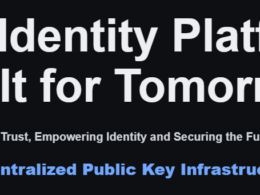In this article I will make a brief summary of the Cardano blockchain and its ecosystem. I will explain some data and metrics, but I will also discuss the essence and vision for which Cardano was built.
Cardano is a blockchain whose technology has abundant technical information, which I will present briefly and ordered by theme, so that you can understand it better, and which you can expand on in articles that I will refer to.
The Beginning
Cardano was founded by Charles Hoskinson and Jeremy Wood. Charles Hoskinson was also one of the co-founders of the Ethereum network. IOHK was created in 2015, of which Charles is its CEO, is the developer company. It currently has 451 members, and is one of the most important blockchain infrastructure research and engineering companies in the world.
The ongoing professional research work, which characterizes Cardano, is based on peer review, totaling 141 Research Papers.
In addition, in the construction of Cardano, two other companies, Emurgo and the Cardano Foundation.
Emurgo develops, supports and incubates business opportunities and helps integrate companies to the blockchain system. It is essentially the for-profit arm of Cardano.
The Cardano Foundation is an independent body that oversees the advancement of Cardano and its ecosystem. As the legal custodian of the protocol and owner of the Cardano brand, the Foundation works to drive adoption and partnerships, grow the Cardano community globally, and advocate for favorable trade regulations and legislation. It has an Ambassador program, made up of members of the community, who voluntarily spread the values of the ecosystem.
The name was chosen in honor of Gerolamo Cardano, (or Girolamo), who was an Italian Renaissance physician and mathematician, astrologer, and a student of chance, (September 24, 1501–September 21, 1576).
Augusta Ada King, Countess of Lovelace, known as Ada Lovelace (1815–1852), was an English mathematician and writer who wrote the first algorithm used on a computer, making her the first computer programmer. To honor his vision, the creators of Cardano decided to name the cryptocurrency “ADA”, its symbol ₳, and its smallest subunit “Lovelace”, valued at ₳0.000001 or 1,000,000 Lovelaces represents 1 ADA.
The Cardano blockchain started on 2017–09–23 at 21:44:51, and you can see the genesis block here:
The Essence
Cardano’s mission is to build RealFi, that is, “real” finance on blockchain technology, aimed at people who need new ways to access finance, creating that “real” value that is often missing in DeFi (1).
The consensus of the network is the Proof of Stake (PoS) (2).
It is based on these three design principles:
- Scalability: it seeks to increase the number of transactions per second with low network cost (3)
- Decentralization: the forging of blocks and the developments in the network are produced by a variety of actors
- Interoperability: it promotes its interaction with other blockchains (4)
- Sustainability: has a Treasury system to pay for future developments and growth
Scalability is related to the two-tier design. The Transactional Layer, where the accounting book (ledger) with its balances is located, and it is the layer where the transactions are settled, and the Ouroboros consensus algorithm is executed, and the Computational Layer, which is where the execution of the contracts takes place intelligent
Plutus is a new language developed by IOHK based on Haskell, used to program in Cardano. Haskell is an old functional programming language. The main advantage of having a functional programming paradigm is that each piece of code can be mathematically verified and this means that it is much more difficult to make mistakes when programming smart contracts.
Cardano’s evolution is determined by 5 eras, where each one has a goal. Byron was the foundational one, Shelley the era of decentralization, Goguen the era of smart contracts, Basho the era of scalability, and Voltaire the era of governance. The eras develop over time, some of them in parallel. The start of each era is triggered by a scheduled hard fork event, powered by the Hard Fork Combinator (invented by IOHK). The Next Hard Fork will be Vasil (5).
In this infographic of my authorship, I show you the times:
The Metric
The blockchain divides its time into blocks, epochs and slots. Each epoch lasts 5 days, and includes 432,000 slots, since each slot is opened for every second to choose a node, (5 days x 24 hours x 60 minutes x 60 seconds). On average, one node is expected to be nominated every 20 seconds, for a total of 21,600 nominations per epoch. If randomly chosen slot leaders produce blocks, each of them will be added to the chain. The other candidate blocks will be discarded.
Thus, approximately 21,600 blocks are created in each epoch, but due to the randomness implemented in the protocol, more or fewer blocks can be created.
The consensus algorithm used in Cardano is called Ouroboros, and it is a version of Cardano’s own Proof of Stake (PoS). A leader of the interval (slot) is randomly selected, with a better probability the more tokens he has (stake), to have the opportunity to create a new block.
The protocol provides security, mathematically verifiable against attacks, since to hack the consensus and steal coins, it is necessary that 51% of the participation is in the hands of one or more dishonest participants who are colluding. This is why the selection of leaders to forge blocks is random. Today, for a Sybil attack, typical in this type of protocols, (greater than 50% of the currency holdings) a minimum of ₳12 billion of staking holdings would be needed, out of the total staking of ₳24 billion (make accounts to the price in dollars).
This year 2022, the delegation has grown, and currently it has held over 70% of the circulating, which is considered significant, since not all the circulating is in the hands of the community, since part of it is in the Treasury, that is to say that 100% of the circulating in delegation will never be possible.
The most important measure of decentralization is that of network consensus, and it refers to the distribution of delegation. Single pool operators hold 19% of the same Stake In Pool Group Distribution. The Minimum Attack Vector (MAV) is the number of actors that add up to +51% of the consensus, and if they were malicious they could plot to attack the consensus. Cardano’s MAV remains at 22 and Bitcoin’s is 5, due to its concentration in large mining farms. Cardano can currently be considered with a healthy decentralization (6).
The protocol continues to evolve in its different versions:
- Ouroboros Classic
- Ouroboros BFT
- Ouroboros Praos
Then they will come:
- Ouroboros Genesis
- Ouroboros Hydra
The Ouroboros protocol configuration has calculation parameters, from the minimum fixed cost that the stake pools must register, the incidence of the pledge, the block size, the maximum size for transactions, the deposit per staking key, etc. All of them can be modified to generate the desired changes. You can see all the parameters and their values here.
The best known, due to their impact on rewards, are:
- a0, which is a value that determines the amount of rewards that are granted per signed block according to the pledge that guarantees each stake pool, and since it is currently very low, it does not generate much difference to be chosen as slot leader
- k (described as nOpt) that indicates the desirable number of pools that can sign blocks at the same time, currently k=500. Thus, the parameter k establishes the so-called saturation point, that is, from how much staking in a pool the rewards begin to decrease, and the more the saturation point is exceeded, the more they decrease. To obtain the amount of saturation, Maximum pool size = (45bn – reserves) / k
How do transaction fees work?
Every time someone wants to transfer an amount of ADA, the network fee is calculated. For the transaction to be valid, a minimum fee must be included (although the sender is free to pay higher fees if they wish). All transaction fees are collected in a virtual fund and subsequently distributed among the consensus participants.
The minimum fees for a transaction are calculated according to the formula: a + b × size, where:
- a: is a constant
- b: is a constant
- size: is the size of the transaction in bytes.
Minimum fee. A transaction of 200 bytes in size (fairly typical) costs:
0.155381 ADA + 0.000043946 ADA/byte × 200 byte = 0.1641702 ADA.
Simple transactions, with a low amount of UTxO, usually have a weight between 0.03 and 0.10 KB. The weight increases with the increase in UTxOs, also with added metadata, or with NFT.
The protocol has maximum parameters per block, it admits up to 65,536 bytes per block, or 64 KB (1,024 bytes = 1 KB), that is, no more tx than that total weight can be validated in each one. Each tx cannot be larger than 16,384 bytes (16 KB). The header of each block has a maximum of 1,100 bytes (1.07 KB). This is why the maximum weight of a transaction will be:
₳0.155381 + 0.000043946 ADA/byte × 16,384 byte = ₳0.875392264
The Accounting Model: eUTXO
The accounting system used in Cardano (as in Bitcoin and other blockchains) is the Unspent Transaction Output. The accounting model most used in the crypto industry is that of accounts, in the Ethereum Blockchain, for example (7).
With the model, instead of removing just the amount of cryptocurrency to be transferred from the address, the total for that address is subtracted to zero, and the money part is transferred to the destination address and the balance is deposited in a new address on the wallet created by the protocol for the owner who made the expense. This system avoids double spending.
The eUTXO model is an evolution of the original, it includes:
- Implementing a smart contract language more powerful than Bitcoin Script
- Providing smart contract developers with an area within UTXOs to store the state of their smart contract protocols
- Allow native first-class assets to be stored within UTXOs, in addition to the base network asset
Staking
Unlike the Proof of Work (PoW) consensus protocol, the Proof of Stake allows those who do not run a validator node to participate in the network consensus, delegating participation with your ADAs in a node, and get rewards for it (8).
The official wallets are Daedalus or Yoroi, but there is also ADAlite, Eternl, GeroWallet, Typhon or Nami, which have a good reputation (wallets) (9).
The Monetary Policy
The monetary policy of Cardano is sound, it is established without burning ADAs, unlike other blockchains that manipulate their cryptocurrencies. The total supply set is 45 billion ADAs. It will never change, thus making ADA coins a precious resource because of its scarcity. Currency is currently over ₳33.5 billion, ~75% of the total.
Approximately 2.5 billion ADA was allocated to IOHK after the network launched, another 2.1 billion to EMURGO, and 648 million to the Cardano Foundation.
With the circulation of coins, two issues are addressed from the fee of their transactions, the need to offer rewards to the people who participate in the consensus of the network, and the financing of the treasury (10).
Decentralized Governance
The Voltaire era is Cardano governance. The financing of the Treasury has the objective of providing funds to develop the activities of Cardano in the Catalyst Project, through the community voting process, which has financed 939 projects for more than USD 25 million in its 8 financing Funds.
The Cardano treasury system is transparent, and is financed from:
- 20% of the rewards of each epoch,
- 20% of the monetary expansion of each epoch, and
- donations
The Treasury began its financing with the Shelley era, in the epoch 208, on July 29, 2020, and to date adds over ₳900 million (11).
In the future the network will have its governance DAO (12) to further decentralize the ecosystem, changing IOHK’s dependency on main development, for the choice of the community, to decide the path that Cardano will take.
…
References
(1) Cardano Proposes to Take DeFi One Step Further: RealFi (Back to reading)
(2) Proof of stake vs. Proof of work (Back to reading)
(3) Speed in the Shelley era (Back to reading)
(4) Blockchain Interoperability: Lights and Shadows — Part 1 (Back to reading)
(5) Basho Era Progresses with ‘Vasil’ Hard Fork (Back to reading)
(6) The Cardano Minimum Attack Vector (And why you should care) (Back to reading)
(7) Accounting Models in Blockchain: UTxO, eUTxO and Account Models (Back to reading)
(8) What you should know about Cardano (Back to reading)
(9) An Influx of Wallets Are Entering the Cardano Ecosystem. Which One Should You Use? (Back to reading)
(10) Taking a Look at Cardano’s Monetary Policy (Back to reading)
(11) Governance in The Voltaire Era and The Cardano Treasury (Back to reading)
(12) Decentralized Autonomous Organization (DAO): The Brief History, Challenges, and Lessons Learned (Back to reading)











How can you write an article about its history and leave out that it started as a japanese gambling token?
You can add any blockchain related content at coinsfolks.